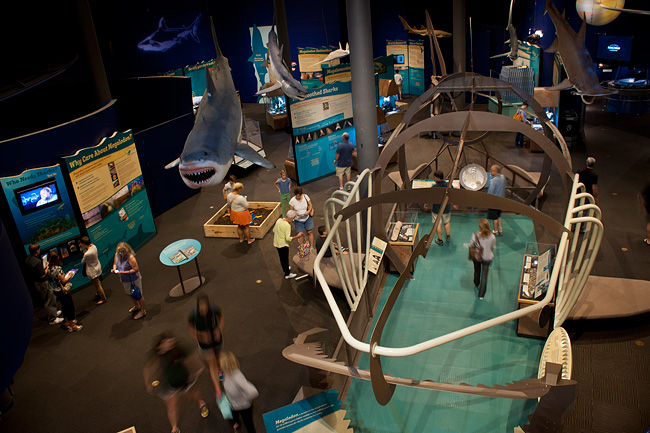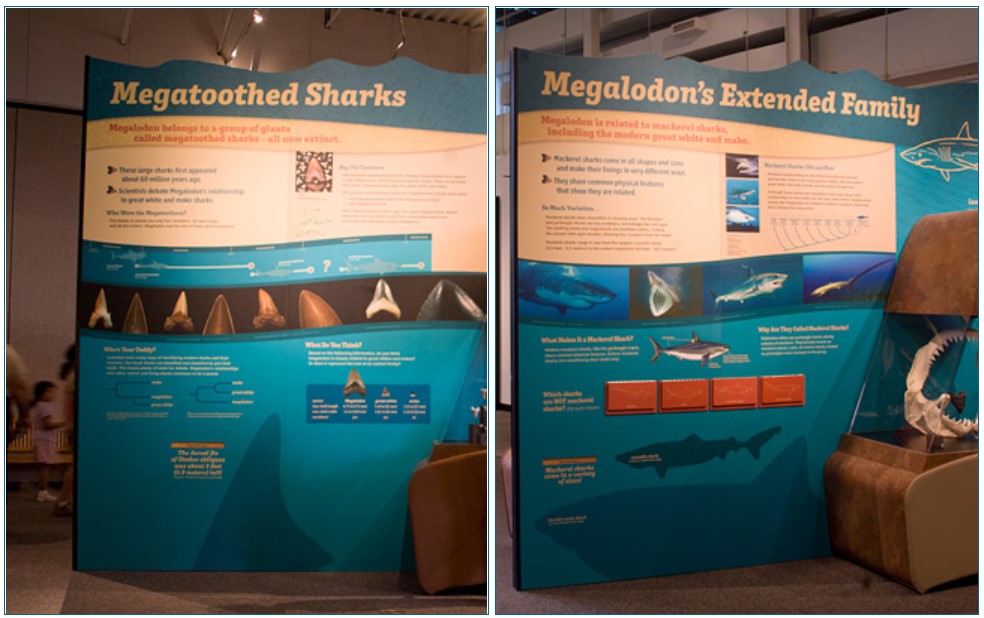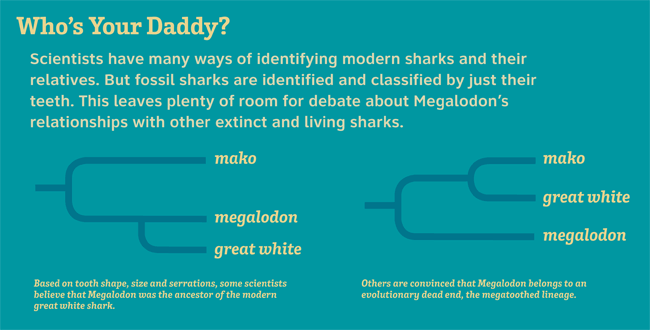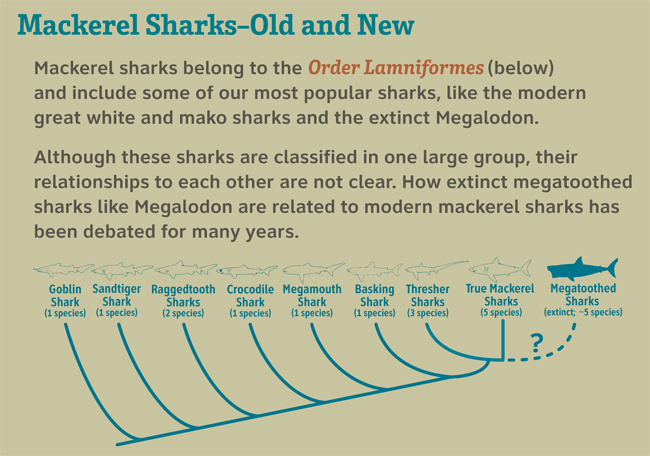
In 2014, Laura Novick, Associate Professor of Psychology and Human Development at Vanderbilt University, interviewed Betty Dunckel, Program Director at the Florida Museum of Natural History, about an exhibit on shark biology and conservation, which includes three evolutionary trees. Explore excerpts from that interview to find out how the exhibit illustrated scientific uncertainty and what they might do differently next time.
- Exhibit summary
- Choosing the trees
- Representing uncertainty
- How effective was it?
- Recommendations
- A tree makeover
Exhibit summary
The institution: Florida Museum of Natural History, Gainesville, Florida, annual visitorship of almost 200,000.
The exhibit: The 5000-square-foot exhibit Megalodon: Largest Shark that Ever Lived opened in 2007 and explains this shark’s biology, including its living relatives, evolution, and extinction. The exhibit incorporates many fossils, models of sharks, and interactive components. Three trees are included in the exhibit’s panels. Two of them illustrate different hypotheses about the relationship between megalodon and great white sharks. The other tree shows the relationships among major shark clades and megalodon. However, the primary learning goal of the exhibit was to teach about megalodon and shark conservation, and the trees are relatively minor components of the exhibit.

Goals for the tree:
- To illustrate the idea that megalodon is closely related to mako sharks
- To illustrate scientists’ uncertainty about exactly how megalodon is related to present day great white sharks and other mako sharks.
Who worked on the exhibit: Many staff members including scientists, curators, a project manager, an exhibit director, graphic designers, and an educator.
Choosing the trees
The exhibit is basically about megalodon and modern sharks, so that’s why we picked these taxa for the trees. We have a large paleontology collection, and sharks are locally relevant in Florida. Megalodon fossils are found in Florida, and shark teeth can be found in creek beds in Gainesville. Also, we are the home of the International Shark Attack File, and Florida is surrounded by water. So there is a continuum from the fossil history right up until sharks today. Plus, sharks attract attention, and we know that large extinct animals attract attention. This was certainly an exhibit that made sense for the institution.

Trees were not a primary focus of the exhibit though. Bruce MacFadden, a curator at the Museum, heard a presentation at a scientific conference about a study at the Smithsonian that found that visitors had a difficult time understanding trees. Therefore, he felt that to focus on them in the exhibit was not a great approach. He wanted to keep the trees simple.
The trees themselves came from the scientific literature on megalodon and closely related sharks. Because they were quite simple, there were minimal challenges with the trees. It would have been much more complex if we’d tried to put in all sharks.
In these trees, we can see three different tree styles. I’m not sure why that was done. Perhaps because of the design of the panels? During exhibit development if there isn’t someone championing a particular approach for scientific or pedagogical reasons, decisions may be made that end up being not the best for fostering visitor understanding.
Representing uncertainty
One of the major roles of the trees in this exhibit was to show that scientists don’t know whether megalodon was more closely related to present day great white sharks or to mako sharks. Scientists really aren’t sure because, for extinct species, the evidence is just fossil teeth; whereas, for modern species, we can use their DNA. This provides an opportunity to point out that science continually changes. As we learn more, we change what we think. Science is too often taught as facts that don’t change.

How effective was it?
Trees were not a primary focus of the summative evaluation, so we don’t know everything we’d want to. One question was how interested visitors were in how closely megalodon was related to modern sharks. Forty five percent of the visitors were very interested and 41% were somewhat interested, which together (86%) shows a lot of interest in the relationships. Findings also suggest that visitors have a far better understanding and appreciation of ecology than evolution.
Recommendations
Visitors were really interested in the theme of the exhibit, so if we had it to do over, we could capitalize on this interest to focus more on improving tree understanding. I would hope that in future exhibits, we make trees more central rather than being the secondary focus. I think there’s lots of ways that we can use what’s known about tree understanding in order to present them graphically in ways that foster understanding. For example, after reading recent work about how showing the characters that support the branching pattern can make a difference, I thought that including characters on the tree would be a really important change in terms of increasing visitor understanding. Then there would be something tangible that visitors know was used to inform the foundation of the tree. I think that says a lot about the process of science and how scientists are making those determinations, which otherwise, just looks like they come out of nowhere. Also, I would hope that in the formative and summative evaluations, we look at tree understanding in a more concerted way.
A tree makeover

Laura Novick commented on what she would do differently if she were going redesign the same trees for better understanding:
The big visual change in the trees that I would make is to change them to the rectangular format because people understand that so much more easily. I would probably also add characters where I could — especially since the teeth seem to be important markers for shark evolution. If that’s true, it could provide a way to link up the trees with the other images and material in the panels. For example, for the larger phylogeny, if some were the same characters I had put on the previous panel with the two smaller phylogenies, that would be helpful because then the museum goers could see, “Oh, this is a small piece of that.”
Diagrams do not transparently convey meaning, and I think that it’s really hard for students and museum goers to understand that any particular phylogeny that you see is usually just a tiny portion of the whole tree of life. You’ve picked out 3 or 6 or 10 particular taxa, and there are actually other taxa that are in between all these different branches. Another thing you could do to help with this is to color code the trees. So if these taxa in the three-taxon trees all appear in the big one, you could draw the three-taxon trees in one color and then draw their branch on the big tree in the same color. That is a way of clearly showing, without needing any words, that these three are really a piece of this bigger tree.

In terms of the exhibit as a whole, it would be good to tie the phylogeny to the idea of shark conservation. Right now, if I’m looking at this exhibit on my own, I’m probably not going to get that; why trees are important for shark conservation is something that would have to be in here. You would have to say, “Megalodon went extinct. What happened? And why do we need to know this today? Which current species is this important for? Presumably it’s important for extant species that are most closely related to megalodon. So it’s important therefore that we figure out who megalodon is most closely related to.” I think that link would need to be explicit.
